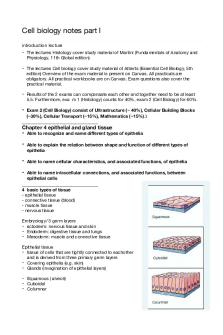Histology notes 1 PDF

| Title | Histology notes 1 |
|---|---|
| Course | Cells and Development |
| Institution | University College London |
| Pages | 2 |
| File Size | 76.3 KB |
| File Type | |
| Total Downloads | 72 |
| Total Views | 148 |
Summary
Lecture notes and additional research notes from module recommended textbook....
Description
[01] Lecture
Cellular Architecture of the body-an introduction
Aim To introduce the concept of the organisation of cells into tissues, and to understand some microscopic features of the human body.
1. 2.
Cells that are specialised in function a
Cells arrange together to form tissues
b
The classical, histological concept of the four primary tissue types: connective tissue muscle tissue epithelial tissue nervous tissue
3.
The term tissue is hard to define rigorously. Nevertheless, the classical concept of the four primary tissues is an extremely useful tool when we try to make sense of how the organs of the body are built and how they function. Organs are made up of tissues.
4.
Multicellular living systems consist not only of cells. They consist in fact of two major components: a cells b the substance that is found between cells. This is called extracellular matrix (ECM). It has two components: (i) fibres, visible in the microscope, (ii) a non-fibrous network of complex molecules that bind tissue fluids. The ECM is normally considered to belong to connective tissue (fibrous tissue, supporting tissue). The difference between different body structures, for instance a muscle, nerve, or gland, results from the properties of their cells as well as from the composition and quantity of the ECM they contain.
5.
Just as cells organize into tissues in an orderly way, tissues relate to one another according to certain basic ‘rules’. For example: a tissues are often arranged in adjacent layers. Striking examples are the wall of a blood vessel or a gut wall. b underneath epithelia you always find connective tissue. c blood vessels and nerves travel in connective tissue. d connective tissue is unique in being all over the body: with the major exception of the central nervous tissue and epithelial sheets, essentially all cells in the body are surrounded by significant amounts of connective tissue. Specialised connective tissue: bone, cartilage, fat, blood.
6. Epithelia – there are several kinds depending on how many layers of cells they contain and the shape of the cells. The different epithelial types have differing functions specific for particular organs. 7. Muscle – Three kinds: skeletal, smooth and cardiac, found in different regions of the body with different functions.
MMB-01
1
8. Nervous tissue – central nervous system: brain, spinal cord; peripheral nervous system: all other nerves in body
MMB-01
2...
Similar Free PDFs

Histology notes 1
- 2 Pages

Histology Notes
- 40 Pages

Histology Notes
- 4 Pages

Histology - Complete Lecture Notes
- 40 Pages

Histology notes - MARIEB
- 5 Pages

Histology 1 notes first year anatomy
- 38 Pages

Histology pratical exam notes part 1
- 29 Pages

Full Histology Notes
- 263 Pages

Activity 1 - Histology Drawings
- 6 Pages

Ch 3 Histology-1
- 6 Pages

Histology Flashcards Semester 1
- 48 Pages

Histology EX 1 study guide
- 15 Pages

Histology of the Ear notes
- 6 Pages

Histology-Trans-1 - study well
- 3 Pages

Activity 1-6 - From histology
- 21 Pages
Popular Institutions
- Tinajero National High School - Annex
- Politeknik Caltex Riau
- Yokohama City University
- SGT University
- University of Al-Qadisiyah
- Divine Word College of Vigan
- Techniek College Rotterdam
- Universidade de Santiago
- Universiti Teknologi MARA Cawangan Johor Kampus Pasir Gudang
- Poltekkes Kemenkes Yogyakarta
- Baguio City National High School
- Colegio san marcos
- preparatoria uno
- Centro de Bachillerato Tecnológico Industrial y de Servicios No. 107
- Dalian Maritime University
- Quang Trung Secondary School
- Colegio Tecnológico en Informática
- Corporación Regional de Educación Superior
- Grupo CEDVA
- Dar Al Uloom University
- Centro de Estudios Preuniversitarios de la Universidad Nacional de Ingeniería
- 上智大学
- Aakash International School, Nuna Majara
- San Felipe Neri Catholic School
- Kang Chiao International School - New Taipei City
- Misamis Occidental National High School
- Institución Educativa Escuela Normal Juan Ladrilleros
- Kolehiyo ng Pantukan
- Batanes State College
- Instituto Continental
- Sekolah Menengah Kejuruan Kesehatan Kaltara (Tarakan)
- Colegio de La Inmaculada Concepcion - Cebu
